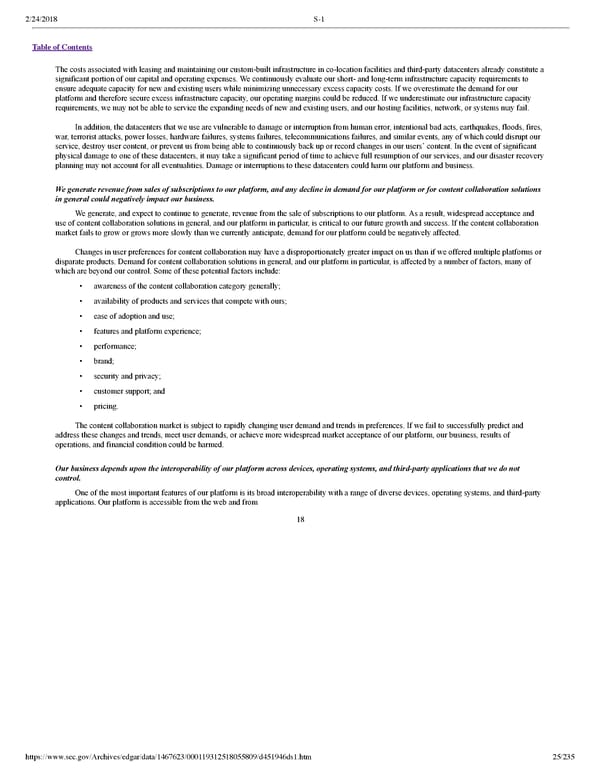2/24/2018 S-1 Table of Contents The costs associated with leasing and maintaining our custombuilt infrastructure in colocation facilities and thirdparty datacenters already constitute a significant portion of our capital and operating expenses. We continuously evaluate our short and longterm infrastructure capacity requirements to ensure adequate capacity for new and existing users while minimizing unnecessary excess capacity costs. If we overestimate the demand for our platform and therefore secure excess infrastructure capacity, our operating margins could be reduced. If we underestimate our infrastructure capacity requirements, we may not be able to service the expanding needs of new and existing users, and our hosting facilities, network, or systems may fail. In addition, the datacenters that we use are vulnerable to damage or interruption from human error, intentional bad acts, earthquakes, floods, fires, war, terrorist attacks, power losses, hardware failures, systems failures, telecommunications failures, and similar events, any of which could disrupt our service, destroy user content, or prevent us from being able to continuously back up or record changes in our users’ content. In the event of significant physical damage to one of these datacenters, it may take a significant period of time to achieve full resumption of our services, and our disaster recovery planning may not account for all eventualities. Damage or interruptions to these datacenters could harm our platform and business. We generate revenue from sales of subscriptions to our platform, and any decline in demand for our platform or for content collaboration solutions in general could negatively impact our business. We generate, and expect to continue to generate, revenue from the sale of subscriptions to our platform. As a result, widespread acceptance and use of content collaboration solutions in general, and our platform in particular, is critical to our future growth and success. If the content collaboration market fails to grow or grows more slowly than we currently anticipate, demand for our platform could be negatively affected. Changes in user preferences for content collaboration may have a disproportionately greater impact on us than if we offered multiple platforms or disparate products. Demand for content collaboration solutions in general, and our platform in particular, is affected by a number of factors, many of which are beyond our control. Some of these potential factors include: • awareness of the content collaboration category generally; • availability of products and services that compete with ours; • ease of adoption and use; • features and platform experience; • performance; • brand; • security and privacy; • customer support; and • pricing. The content collaboration market is subject to rapidly changing user demand and trends in preferences. If we fail to successfully predict and address these changes and trends, meet user demands, or achieve more widespread market acceptance of our platform, our business, results of operations, and financial condition could be harmed. Our business depends upon the interoperability of our platform across devices, operating systems, and thirdparty applications that we do not control. One of the most important features of our platform is its broad interoperability with a range of diverse devices, operating systems, and thirdparty applications. Our platform is accessible from the web and from 18 https://www.sec.gov/Archives/edgar/data/1467623/000119312518055809/d451946ds1.htm 25/235
 Dropbox S-1 | Interactive Prospectus Page 24 Page 26
Dropbox S-1 | Interactive Prospectus Page 24 Page 26